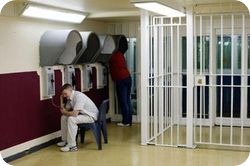One area where the United States indisputably leads the world is incarceration.
The United States has 2.3 million people behind bars, almost one in every 100 Americans. The U.S. prison population has more than doubled over the past 15 years, and one in nine black children has a parent in jail.
Proportionally, the United States has four times as many prisoners as Israel, six times as many as Canada or China, eight times as many as Germany and 13 times as many as Japan.
With just a little more than 4 percent of the world’s population, the United States accounts for a quarter of the planet’s prisoners and has more inmates than the leading 35 European countries combined. Almost all the other nations with high per capita prison rates are in the developing world.
There’s also a national election in the United States soon. This issue isn’t on the agenda. It’s almost never come up with Republican presidential candidates; one of the few exceptions was at a debate in September when the audience cheered the notion of executions in Texas.
Barack Obama, the first black president, rarely mentions this question or how it disproportionately affects minorities. More than 60 percent of the United States’ prisoners are black or Hispanic, though these groups comprise less than 30 percent of the population.
“We’ve had a race to incarcerate that has been driven by politics, racially coded, get-tough appeals,” said Michelle Alexander, a law professor at Ohio State University who wrote “The New Jim Crow: Mass Incarceration in the Age of Colorblindness.”
The escalating cost of the criminal-justice system is an important factor in the fiscal challenges around the United States. Nowhere is that more evident than in California, which is struggling to obey a court order requiring it to reduce its overcrowded prisons by 40,000 inmates.
Today, there are 140,000 convicts in California’s state prisons, who cost about $50,000 each per year. The state pays more on prisons than it does on higher education.
Yet the prisons are so crowded — as many as 54 inmates have to share one toilet — that Conrad Murray, the doctor convicted in the death of the pop star Michael Jackson, may be able to avoid most prison time.
California isn’t unique. In Raleigh County, West Virginia, the county commission has worried that the cost of housing inmates at its Southern Regional Jail may imperil basic services, including education. That problem is exacerbated as the state keeps more prisoners longer at such regional facilities to alleviate its overcrowding problems.
The prison explosion hasn’t been driven by an increase in crime. In fact, the crime rate, notably for violent offenses, is dropping across the United States, a phenomenon that began about 20 years ago.
The latest F.B.I. figures show that murder, rape and robberies have fallen to an almost half-century low; to be sure, they remain higher than in other major industrialized countries.
There are many theories for this decline. The most accepted is that community police work in major metropolitan areas has improved markedly, focusing on potential high-crime areas. There are countless other hypotheses, even ranging to controversial claims that more accessible abortion has reduced a number of unwanted children who were more likely to have committed crimes.
However, one other likely explanation is that more than a few would-be criminals are locked up. Scholars like James Q. Wilson have noted that the longer prison terms that are being handed down may matter more than the conviction rates.
This comes at a clear cost. For those who do ultimately get out, being an ex-con means about a 40 percent decrease in annual earnings.
Moreover, research suggests that children from homes where a father is in jail do considerably less well in life and are more prone to becoming criminals themselves.
“People ask why so many black kids are growing up without fathers,” said Ms. Alexander. “A big part of the answer is mass incarceration.”
It seems clear that the U.S. penal system discriminates against minorities. Some of this is socioeconomic, as poorer people, disproportionately blacks and Hispanics, may commit more crimes.
Much of the inmate explosion and racial disparities, however, grow out of the way the United States treats illegal drugs. It began several decades ago with harsher penalties for crimes involving crack cocaine, which was more widely used by blacks, than powder cocaine, which was more likely to involve whites. A larger issue is how the U.S. criminal justice system differentiates in its treatment of drug sellers — who get the book thrown at them — versus drug users, who, at most, get a slap on the wrist.
A hypothetical example: A black kid is arrested for selling cocaine to the members of a fraternity at an elite university. The seller gets sent away for 25 years. The fraternity is put on probation for a semester by the university and nothing else.
In all likelihood, the convicted seller is quickly replaced, and few of the fraternity kids change their drug-use habits. The lesson: neither the supply nor the demand has changed, and the prison population grows.
Given their budgetary difficulties, about half the states are actually reducing their prison populations. Smart selective policies are cost-effective. Many criminologists and sociologists say the proclivity to commit crimes diminishes with age; the recidivism rate for convicts over 30 is relatively low, and most every analysis suggests that parole and probation are far less expensive for taxpayers than incarceration.
Nevertheless, the politics of the crime issue cuts against any rational approach. Even if recidivism rates are low, it’s the failures that attract attention. In 1988, the Democratic presidential nominee, Michael S. Dukakis, was savaged when it was revealed that one convict, Willie Horton, who was furloughed on his watch as governor of Massachusetts committed a rape while at large. Four years ago, the former governor of Arkansas, Mike Huckabee, a Republican, was hurt in his bid for his party’s nomination by reports of crimes committed by felons who were paroled during his time in office.
“One case where a parolee does something very wrong is sensationalized,” Ms. Alexander said, “and many, many others are kept behind bars for a long time.”
Paul Solomon
Executive Director
Sponsors, Inc.
338 Highway 99 North
Eugene, OR 97402
Main Office: 541.485.8341
( Direct: 541.505.5652)
( Fax: 541.683.6196 )
www.sponsorsinc.org
A prison is a trap for catching time. Good reporting appears often about the inner life of the American prison, but the catch is that American prison life is mostly undramatic—the reported stories fail to grab us, because, for the most part, nothing happens. One day in the life of Ivan Denisovich is all you need to know about Ivan Denisovich, because the idea that anyone could live for a minute in such circumstances seems impossible; one day in the life of an American prison means much less, because the force of it is that one day typically stretches out for decades. It isn’t the horror of the time at hand but the unimaginable sameness of the time ahead that makes prisons unendurable for their inmates. The inmates on death row in Texas are called men in “timeless time,” because they alone aren’t serving time: they aren’t waiting out five years or a decade or a lifetime. The basic reality of American prisons is not that of the lock and key but that of the lock and clock.
 An exhaustive analysis of prison phone contracts nationwide has revealed that with only limited exceptions, telephone service providers offer lucrative kickbacks (politely termed “commissions”) to state contracting agencies – amounting on average to 42% of gross revenues from prisoners’ phone calls – in order to obtain exclusive, monopolistic contracts for prison phone services.
An exhaustive analysis of prison phone contracts nationwide has revealed that with only limited exceptions, telephone service providers offer lucrative kickbacks (politely termed “commissions”) to state contracting agencies – amounting on average to 42% of gross revenues from prisoners’ phone calls – in order to obtain exclusive, monopolistic contracts for prison phone services.